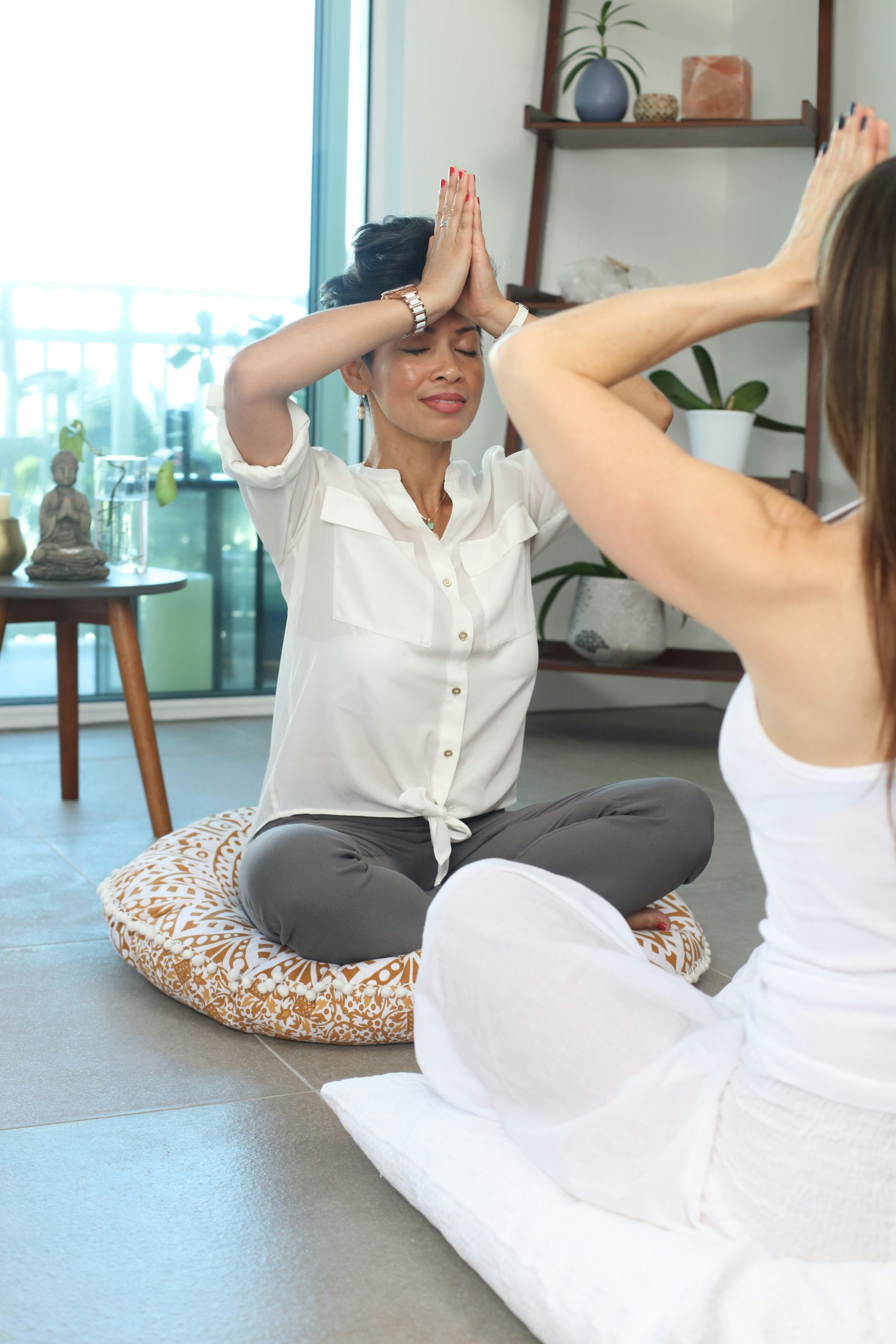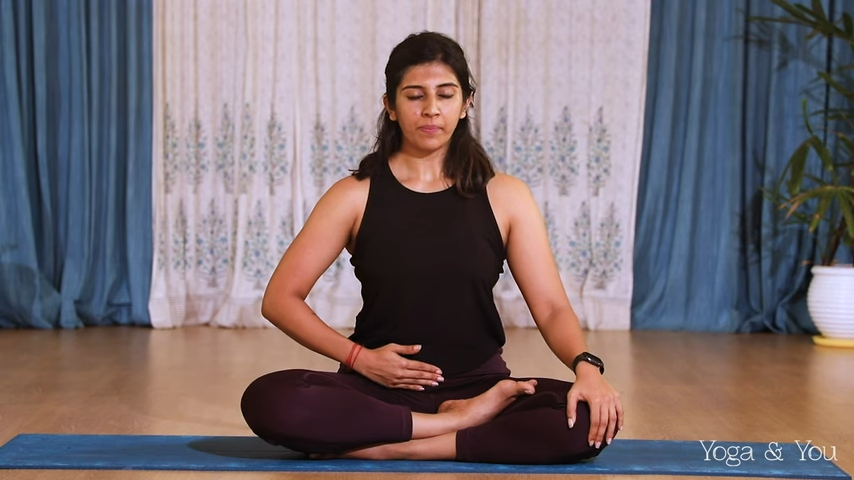One of the practices of Yoga includes your breathing. Through yoga breathing exercises, we can gain awareness and take a level of consciousness with us throughout each day; in every way, we take a breath.
When it comes to our lungs, we have about three liters on average of lunch capacity. When the average person breathes, they typically only breath in and out about 500 ml, or half a liter. Becoming more aware of our breathing will not only help us feel better, but we are doing great things for our bodies.
Here are ten yoga breathing exercises that you can easily practice.
1. Lion’s Breath – Yoga Breathing Exercises

If you’ve ever gone to a yoga class, this pose is ubiquitous and simple to do, although you might feel a little silly when you do it. Doing Lions Breath will have relieved tension in your face and help lower your stress in general. In order to do this pose make a loud “ha” sound, or roar like a loin, while exhaling and sticking your tongue out. Exhale all the negative energy you don’t want to feel and trust us; you’ll instantly feel better.
2. Standing Deep Breathing Pranayama
Pranayama is a vital pose to practice since it controls the movement of our life-force energy through the control of breathing. With that being said, there are several different breathing techniques you can do.
The Standing Deep Breathing Pranayama has you inhale through the nose for a six-count with your fingers interlaced under your chin and arms lifted up, so your elbows are framing your face. Your belly is sucked in, and the lungs are expanded to their maximum capacity during this pose. By doing this it allows fresh, warm oxygen to come to your muscles and organs, plus it gets your blood moving.
You will exhale through the mouth with a loud “ha” sound for a six-count while your head is tilting back, and the elbows are brought down and back together off the chest.
3. Belly Breathing – Yoga Breathing Exercises
Belly breathing is excellent for the nervous system and is usually used in Savasana. Belly Breathing quickly calms the body and reset us, perfect for general relaxation. This post is also known as abdominal or diaphragmatic breathing, and you achieve it by contracting the diaphragm and watching your belly rise and fall while your ribcage is controlled through the diaphragm.
4. Ujjayi Breathing

Ujjayi Breathing is also commonly referred to as Psychic Breath which has you exhaling through the nose, with air forced up and down the back of your throat. This compresses the epiglottis, causing it to make a rasping “oceanic” sound.
The breath through this is settling and rhythmic and works excellent if you’re looking for a good meditation breath.
5. Bee Humming

If you need to be instantly calm and let go of anger, then the Bee Humming pose is for you. Place your index finger onto the cartilage of your ears, against your cheek, to block out external sound. Inhale and make a constant, high-pitched bee-humming sound.
You can leave your fingers pressed in or press your fingers in and out during the humming. You can repeat the pattern six or seven times until you feel calm.
6. Kapalbhati Blowing – Yoga Breathing Exercises

Kapalbhati Blowing is the opposite breathing technique of what we have been talking about. This breathing technique focuses on short, sharp exhalations. The point of the breath is to tone and purify, releasing any stale air from the body after practicing asana. It also helps clear the sinuses and respiratory system.
To achieve this pose, imagine pulling your belly button in and out with a strong as you blow out sixty steady, quick breaths.
7. Alternate Nostril Breathing

Alternate nostril breathing might sound like a peculiar technique, but it’s actually a quite beneficial pratice effective in relaxing one’s body and mind; significantly reducing anxiety and promoting one’s overall well-being. Alternate nostril breathing is rather self-explanatory and consists of conscious inhalation through one nostril and subsequent nostril exhalation through the other.
Additional benefits of alternate nostril breathing consist of a more composed comportment; the diminution of persistently high stress levels; enhancement of one’s lung function and respiratory endurance; and the de-escalation of one’s heart rate.
8. Focusing on Inhalation

Breathwork, otherwise known as pranayama, can be one of the most critical components of your yoga practice. Research further evinces the overall effectiveness of breathwork, as respondents who participated in several studies assessing the overall effectiveness of breathworks; demonstrated less anxiety, stress mitigation, reduced depression and notably improved.
In order to engage in pranayama, place your focus on your breath, noting particularly when it slows or whether it speeds. Observe the inhalations and exhalations without any manipulation, observing the natural rhythms of your body. Such conscientiousness with respect to a natural bodily process can reduced blood pressure, pain and troubling and anxiety.
9. Focusing on Exhalation – Yoga Breathing Exercises

Sometimes referred to as “Sitali breath,” focused exhalation is oriented around the concept of slightly extending one’s breath. Merely inhale through your mouth, and flesh out your ensuing exhalation, making it as pronounced as possible. Continue this practice for 5 or so minutes. Since Sitali is a slightly more rigorous breathing exercise, you may want to identify a setting without an abundance of natural allergens and pollution.
10. Attaching an Emotion
When you attach an emotion to your breathing, it helps give you a sense of purpose. Try to imagine breathing in love and breathing our anger, or inhale joy and exhale gratitude or forgiveness. By doing that you are controlling your breathing and giving yourself something more to focus on while breathing.
Holding your breath is another excellent strategy when it comes to practicing your breathing. It allows you to have stillness and quietness, testing your strength, and sensing what your body is fully capable of.
Related articles:
10 Benefits of Breathworks
5 Ways Yoga Can Help Relieve Arthritis
For further reading common yoga practices, please reference the following articles.
5 Anti-Aging Yoga Moves
Great Yoga Poses to Help Relieve Lower Back Pain




